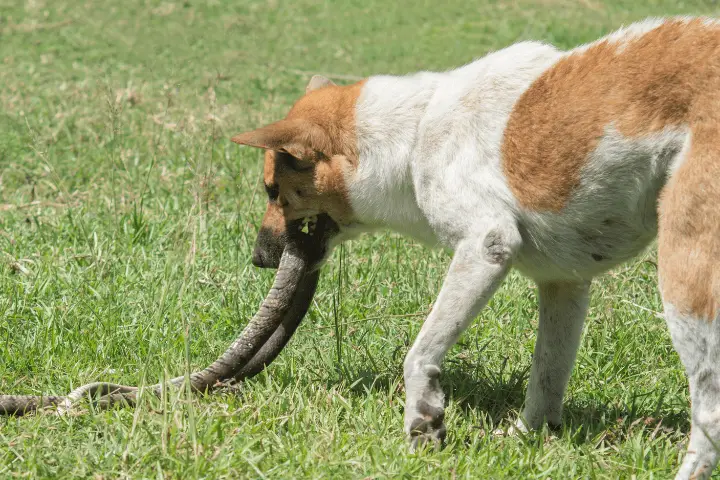Are Black Snakes Poisonous To Dogs
Snakes are a common fear for many people, and when it comes to our furry friends, the concern is amplified.
Dogs are curious creatures, often getting themselves into situations that can put them in danger.
Knowing the threat black snakes can pose is essential for any pet owner.
Black snakes, or black racers, are a species of non-venomous snakes. Even though they don’t have venom, they can still be a hazard to dogs.
That’s because dogs might mistake them for more dangerous snake types or start playing, provoking the snake’s defensive instincts.
Black snake bites can hurt and cause swelling. Plus, if untreated, they could lead to infections.
Black snakes may not be venomous or deadly to dogs, but they can still be dangerous.
Are Black Snakes Poisonous to Dogs?
Explanation of venomous and non-venomous snakes
Venomous snakes have venom glands that produce toxic substances. These snakes inject venom through their fangs.
Non-venomous snakes don’t possess this ability. This is essential to know when assessing the danger to dogs.
The color of a snake doesn’t determine its toxicity. To know the true nature of a snake, you have to identify the species.
For instance, the eastern indigo snake is non-venomous and doesn’t pose any threat to dogs. In fact, they help control rodent populations.
On the contrary, some black snake species, like the African black mamba, are highly venomous and their bites can be fatal for both humans and animals, including dogs.
Thus, it’s important to take caution and avoid them to keep our four-legged friends safe.
Differentiating between venomous and non-venomous snakes
When identifying venomous and non-venomous snakes, there are certain traits to look for. Venomous snakes have triangular heads, vertical pupils, hollow fangs, usually keeled scales, and a short tail.
Non-venomous snakes, on the other hand, have rounded heads, round pupils, no hollow fangs, smooth scales, and a long tail.
Another factor to consider is that venomous snakes have heat-sensitive pits located between their eyes and nostrils – this helps them detect prey.
Precautions for Dogs
Keeping dogs away from snakes
Keep your yard free from clutter and tall grass to avoid snakes taking up residence. When your pup hits the trails or open fields, make sure they stay on a leash.
Teach your pup ‘leave it’ and ‘stay’ commands for a quick escape from slithering serpents. Always be aware of what’s around you, and look out for any signs of snakes, like skin or movement.
Snake repellents are an option, but ensure you use pet-safe products and follow the instructions. If you happen to come across a snake while out with your pup, stay cool and slowly move away.
Not all snakes are venomous, but it’s better to be safe than sorry. For extra tips on keeping your pup safe from snakes, consider consulting a professional.
To sum it up: teach your pup the ‘slither shuffle’ and remain vigilant to keep them out of harm’s way.
Teaching dogs to avoid snakes
It’s essential to understand the danger snakes can pose to dogs – their venomous bites can be fatal. Train your pup to immediately obey a command such as “Leave it” or “Stay away” to keep them safe.
Gradually expose your dog to snake-scented objects or simulated encounters, with professional help or assistance from an experienced trainer. This controlled exposure will teach them to associate the sight or scent of snakes with caution.
Also, remove any potential hiding places like tall grass or rock piles, and check your yard regularly for any signs of snake activity, like shed skin or tracks. Remember to stay vigilant when walking or hiking in areas known for snake encounters.
As reported by The Humane Society of the United States, 20% of all bites on dogs are from venomous snakes1. So, be sure to educate yourself about the types of snakes in your area and their behavior.
Signs of snakebite in dogs
Snakebites can be a serious threat to dogs. It’s essential for pet owners to recognize the signs of a bite in their furry friends.
Being conscious of these clues can help provide immediate medical attention, which may even save their lives.
- Swelling: A common indicator of snakebite in dogs is swelling around the affected area. This can happen fast and sometimes with pain or tenderness.
- Puncture marks: Look for two small holes close together and maybe bleeding.
- Weakness or lethargy: Dogs could appear tired, have difficulty moving or even struggle to stand.
- Change in behavior: Your pup may become restless, anxious, or even drool or pant excessively.
Not all snakebites display the same symptoms. Some dogs may have severe reactions, while others only show mild signs initially.
If you think your pup has been bitten, rush to the vet.
Venoms can be harmful and can cause complications if left untreated.
Quick action may make all the difference!
Be aware and know how to identify snakebites.
That way, you can act promptly if needed and ensure your companion gets the best care.

